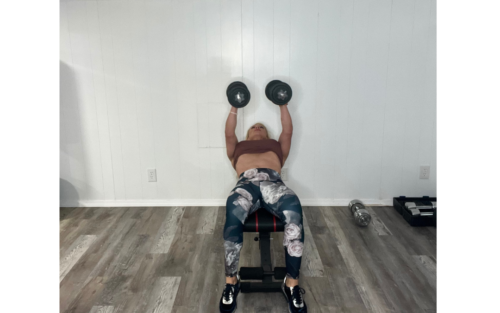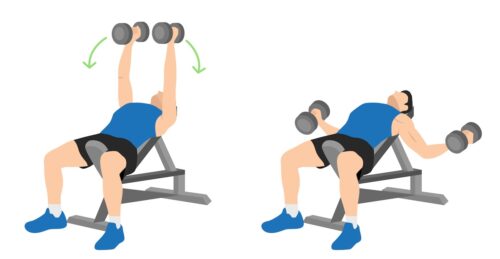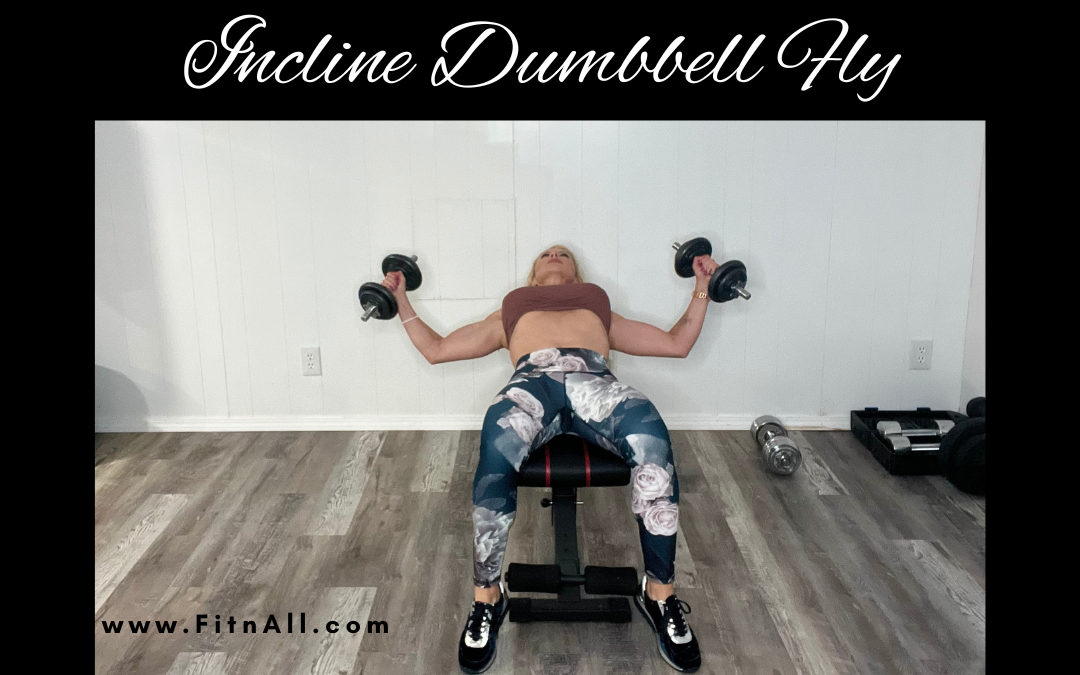Some of the most prominent muscle groups of the upper body that give you a wonderful presence are the chest muscles. Most men love to train the chest area, which is great. However, most women neglect this area. It’s understandable since it’s a weaker area and they feel they don’t need to strengthen it. Yet, the chest muscles should be trained regularly and properly by males and females. A good chest exercise is the incline dumbbell fly.
Below we’ll look deeper into incline dumbbell flys and we’ll cover the following:
- Muscles involved in incline dumbbell flys
- Benefits associated with incline dumbbell flys
- How to do the incline dumbbell fly properly
- Common mistakes when performing incline dumbbell flys
- Video on how to do incline dumbbell flys
- Exercises to complete your chest workout
The incline dumbbell fly is an isolation exercise – a variation of the dumbbell fly. During that exercise, the bench remains flat – not angled up. The incline position allows for higher upper-chest emphasis.
What Muscles Do InclineDumbbell Flys Work?
Primary Muscles:
- Chest Muscles: These are the pectorals, which are divided into the pectoralis major and pectoralis minor. The pectoralis major is the larger one, a fan-shaped muscle comprising most of the chest wall. It keeps your arms attached to your body and is involved in adduction and internal rotation of the arm on the shoulder joint, as well as flapping, pressing, and lifting movements. The pectoralis minor is smaller and flatter. This one lies underneath the pectoralis major and is involved in shoulder functioning.
Secondary Muscles:
- Triceps Brachii: The name triceps is due to the fact that these muscles are composed of three muscle strands (the long, medial, and lateral heads). It specifically targets the long head of the tricep. Triceps are involved in forearm and elbow extension, helping extend or straighten the elbow. They are also involved in shoulder adduction and extension, helping pull the arms down. Additionally, the triceps help to stabilize the shoulder joint. Close grip presses target all three heads of the muscle, especially the long head.
- Deltoids: These are the main shoulder muscles. The anterior deltoid flexes and medially rotates the arm, the lateral deltoid abducts the arm, and the posterior deltoid extends and laterally rotates the arm. The anterior deltoids are very active in close grip dumbbell presses and much more in an incline position.
- Rotator Cuff: A group of muscles and tendons that surround the shoulder joint (supraspinatus, infraspinatus, teres minor, and subscapularis) and are responsible for stabilizing your shoulder joint.
- Serratus Anterior: Muscles on the upper sides of the torso that wrap the rib cage. The main part lies deep under the scapula and the pectoral muscles – in between the pectoralis major and latissimus dorsi muscles. They rotate and draw the scapula anterolaterally.
- Coracobrachialis: Long muscles of the anterior compartment of the arm – deep muscles of the chest and front of the arm, with the boundaries of the axilla. They extend from the coracoid process of the scapula to the shaft of the humerus. Their function is flexion and adduction of the arm at the shoulder joint.
- Trapezius: These diamond-shaped muscles extend from the top of the neck to the shoulder and down toward the mid-back. They attach to the skull, vertebral column, and shoulder girdle. They are involved in the movements of the shoulder girdle.

Incline Dumbbell Fly Benefits
After learning the muscles involved in incline dumbbell flys, let’s look at the vast benefits associated with the exercise:
- Calorie Burner: The dumbbell fly is a multi-joint exercise encompassing many muscles, which helps you to burn more calories and consequently more body fat.
- Aesthetics: Flys mold your upper body nicely – for males and for females. Your chest gets higher and your shoulders and arms develop a great shape.
- Strength: The dumbbell fly strengthens your chest muscles. This translates into more strength to lift, push, and perform tricep exercises and other chest exercises.
- Healthier Bones: Chest presses like other resistance training exercises support bone health and help prevent osteoporosis.
- Increased Power: Power is your capability to exert force, over a given distance as fast as possible. As your upper body becomes stronger performing chest presses, you can increase your power by performing each repetition more intensely.
- Simplicity: There is not a lot of equipment involved. You just need a bench and a set of dumbbells. Plus, anyone can do them. You do not need to be an expert lifter to do chest presses or be of a specific age or sex.
- Versatility: Flyes can be performed with different tools and in various body positions. You can also perform the exercise with resistance bands or cables. You can also change the angle of your body, like on a straight bench, incline, or decline position.
How to Do Incline Dumbbell Flys

- Approach a bench and position it at a slight incline, such as 30 degrees.
- Sit down on the bench, straddling the bench with both feet flat on the floor and relatively wide apart. It’s best to have your feet on the floor rather than placing them on the bench, so you are more stable.
- Grab a pair of dumbbells with a neutral grip and lie back on the bench – If you are using heavy weights, lift a dumbbell at a time and put them on your knees. Then, kick one dumbbell up and over the chest at a time and you lie back.
- Extend your arms over your chest with your elbows slightly bent and palms facing each other. This is the starting position.
- As you inhale, slowly lower the dumbbells to the sides in an arc position until you feel a mild stretch in your chest or shoulders.
- As you exhale, bring the weights back to the starting position, maintaining an arc throughout the movement.
- Repeat the movement for 8 to 12 repetitions and for 3 sets.
- When you are done with the set, rest the weights on your chest or thighs and use your core to sit up.
? If you have shoulder or chest injuries, you should avoid this exercise. If you experience any sharp pain during the bench press, stop the exercise immediately.
Incline Dumbbell Flys Mistakes
Now that you know how to perform dumbbell flys properly, let’s look at the most common mistakes associated with this exercise:
- Bending the elbows too much: When you bend the elbows too much, you shorten the exercise’s range of motion. This doesn’t allow the exercise to target the muscles as efficiently as it should. You should only keep your elbows slightly so you can prevent unnecessary stress on your shoulders and you can perform the fly with proper form.
- Bringing the dumbbells out and down too far: This overstretches the chest and shoulders, increasing your chances for injury. A proper range of motion is key, not too short or too wide.
- Using very heavy weights: You don’t need to lift super heavy weight to benefit. Because of the angle of your arms and your body, very heavy loads can really injure you. Always use a weight that you can control and that can allow you to exhibit proper technique.
- Moving the weights too fast: This is not a power exercise. You should execute it in a controlled manner and concentrate on the chest muscles to isolate them.
- Positioning the bench at a very steep angle: When the angle is higher than a 30-35 degree angle, you are emphasizing the shoulders more than the chest and upper chest muscles.
Incline Dumbbell Fly Video
Chest Workout
You can complete your chest workout by performing the following exercises:
As you can see the incline dumbbell fly is a wonderful chest exercise. It offers tremendous benefits associated with hypertrophy, strength, endurance, and aesthetics. Now that you know how to properly perform incline dumbbell flys, you can avoid the most common mistakes and enjoy their benefits. Remember, whether you want to lose weight, tone your body, or gain strength or size, all muscles must be trained.
Lift, Burn more Fat, Get Stronger, and Live Healthier!
To a Fitter Healthier You,
The Fitness Wellness Mentor



